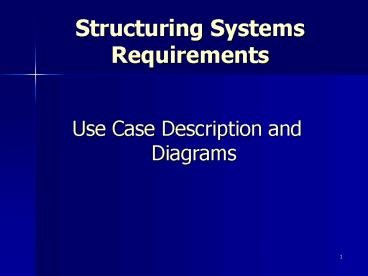Structuring Systems Requirements PowerPoint PPT Presentation
1 / 22
Title: Structuring Systems Requirements
1
Structuring Systems Requirements
- Use Case Description and Diagrams
2
(No Transcript)
3
What Is Requirements Structuring?
- The process of analyzing, organizing, and
modeling the requirements obtained via
interviews, questionnaires, observation, and
document analysis - Relevant UML models (i.e. ways to model the
requirements) include use cases, class diagrams,
interaction diagrams, and activity or statechart
diagrams
4
What Is a Use Case?
- A depiction of a systems behavior, under various
conditions, as the system responds to requests
from users - Interaction of an external entity (or actor) with
the system - The user ? uses the system
- The actor ? represents a role the user can play
5
Use case modeling is utilized to demonstrate
the functionality of a system Interactions
between system and user
6
UML Use Case Diagram Symbols
Use Case
Actor
Boundary
Connection
Include relationship
Extend relationship
7
(No Transcript)
8
What Is an Actor?
- An external entity that interacts with the system
- Most actors represent user roles, but actors can
also be external systems. - An actor is a role, not a specific user one user
may play many roles, and an actor may represent
many users.
9
What Is a Boundary?
- The dividing line between the system and its
environment - Use cases are within the boundary
- Actors are outside of the boundary(i.e. external
entities)
10
What Is a Connection?
- An association between an actor and a use case
- Depicts a usage relationship
- Connection does not indicate data flow
11
What Is an ltltincludegtgt Relationship?
- A connection between two use cases
- Indicates a use case that is used (invoked) by
another use case - Links to general purpose functions, used by many
other use cases - Also called an abstract use case since it is
never performed by itself
12
Functionality is split out into a separate use
case that can be ltltincludedgtgt by other use cases
13
What Is an ltltextendgtgt Relationship?
- A connection between two use cases
- Extends a use case by adding new behavior or
actions - Specialized use case extends the general use case
14
Instructor is not needed for normal registration,
only for special class registration
15
(No Transcript)
16
Include vs. Extend
- Use ltltextendgtgt if you want to model an extension
to, or a variation of, a complete use case that
exists in its own right - Use ltltincludegtgt if you want to factor the common
behavior among two or more use cases into a
single generalized use case
17
Actors can be grouped in generalization
categories.
18
Written Use Cases
- Document containing detailed specifications for a
use case - Contents can be written as simple text or in a
specified format
19
Sample Format for Written Use Case
- Title descriptive name, matches name in use
case diagram - Primary actor usually a user role
- Stakeholders any group or individual with an
interest in the function of the use case - Precondition conditions that must be satisfied
in order to execute the use case
20
Sample Format for Written Use Case (Continued)
- Minimal guarantee outputs that can be expected
if the service attempt failed - Success guarantee outputs that can be expected
if the service succeeds - Trigger an event or action that initiates the
use case - Main success scenario description of sequence
of interactions between actor and use case during
the use case execution - Extensions detailed description of how errors
are dealt with (i.e. else statement that follows
an if-then)
21
A sample written use case
22
- Any Questions?

